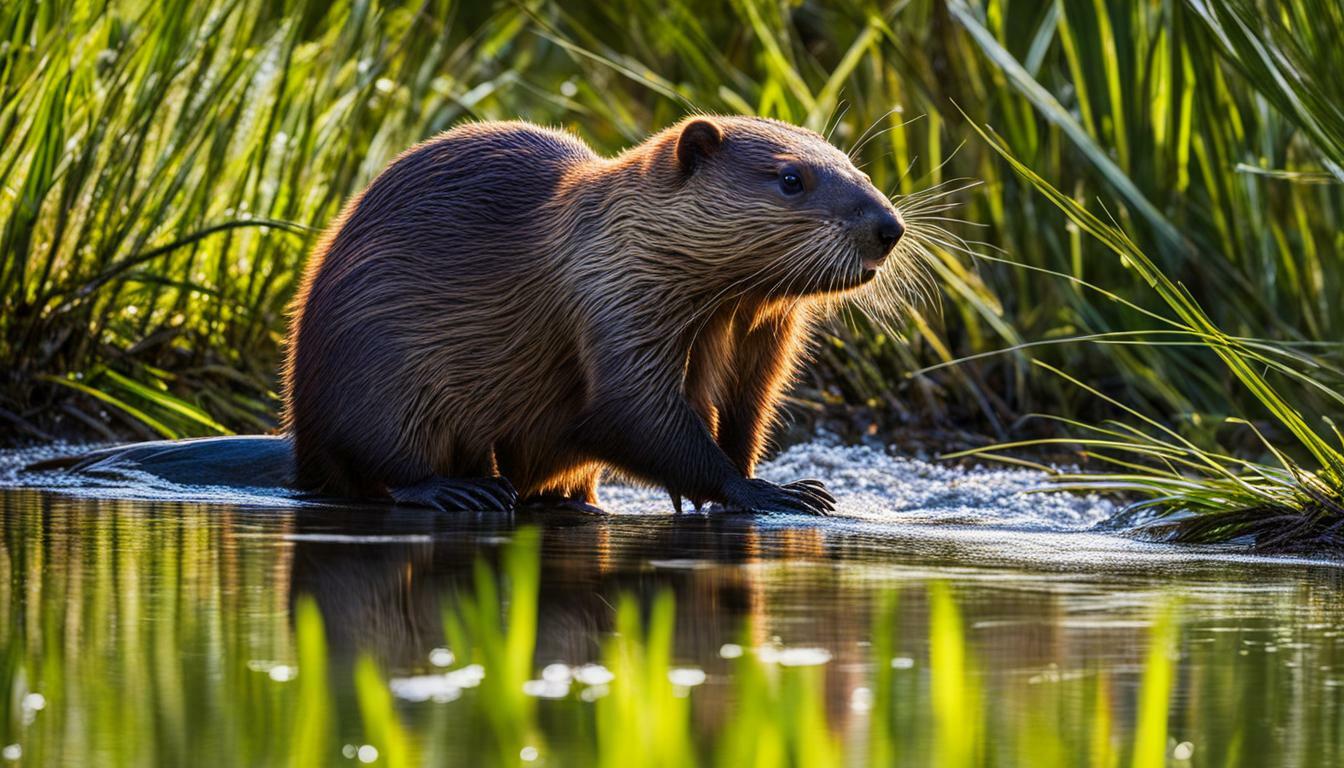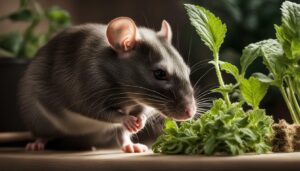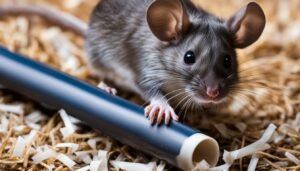If you’ve ever wondered if beavers call Florida home, you’re in for a treat. These fascinating creatures, known for their ability to build dams and redirect water, do indeed live in the Sunshine State. Despite a decline in their population due to hunting and development, conservation efforts have helped increase their numbers.
Florida beavers can be found in various bodies of water such as rivers, streams, springs, sloughs, and lakes. They are the largest rodent species in the state and play a crucial role in the ecosystem. Their remarkable dam-building skills provide nesting areas for other animals, contributing to the overall biodiversity.
Key Takeaways:
- Beavers do live in Florida and are the state’s largest rodent.
- Conservation efforts have helped increase the population of beavers in the state.
- Florida beavers can be found in rivers, streams, springs, sloughs, and lakes.
- They are skilled at cutting down trees and building dams, which create nesting areas for other animals.
- Beavers are primarily nocturnal and have a diverse diet consisting of inner bark, shoots, twigs, and grass.
Furthermore, female beavers give birth to two to four kits, which stay with their parents until they reach maturity at around two years old. So if you ever come across a beaver in Florida, take a moment to appreciate these incredible creatures and the important role they play in our natural environment.
The Habitat of Florida Beavers
Florida provides a diverse range of habitats for its native beavers to thrive in. These industrious creatures can be found in rivers, streams, springs, sloughs, and lakes throughout the state. They are well adapted to the subtropical climate and have successfully carved out their niche in Florida’s natural landscape.
Beavers are known for their ability to create and modify their surroundings to suit their needs. They are particularly skilled at cutting down trees and building dams, which serve multiple purposes. Not only do these dams provide a safe haven for beavers, but they also create a habitat for various other wildlife species.
The Importance of Wetlands
One of the key habitats for beavers in Florida is wetlands. These areas are characterized by the presence of standing water, which is essential for beavers’ survival. Wetlands provide a rich food source for beavers, offering a bounty of aquatic vegetation, shrubs, and trees. They also serve as an ideal location for beavers to construct their lodges, which are elevated structures where they build their nests.
| Beaver Habitat in Florida | Native Beavers in Florida |
|---|---|
| Rivers | Yes |
| Streams | Yes |
| Springs | Yes |
| Sloughs | Yes |
| Lakes | Yes |
Beavers play a vital role in the ecosystem by helping to regulate water levels. Their dams slow down the flow of water, causing it to back up and create wetland habitats. This, in turn, promotes biodiversity by attracting a variety of plants and animals that rely on these unique ecosystems.
Overall, the diverse range of habitats found in Florida provides a favorable environment for native beavers. Their presence not only contributes to the natural beauty of the state but also plays a significant role in maintaining the delicate balance of the local ecosystem.
The Role of Beavers in Florida’s Ecosystem
Beavers in Florida play a crucial role in shaping and maintaining the state’s unique ecosystem. These fascinating creatures, known as the largest rodent in the state, have a significant impact on the environment around them. Let’s explore some interesting beaver facts in Florida and their role in the ecosystem.
Beaver Dams: Engineering Marvels
One of the most remarkable abilities of beavers is their skill in building dams. They construct intricate structures using branches, logs, and mud, which in turn creates ponds and wetlands. These habitats created by beaver dams attract a variety of wildlife, including fish, turtles, birds, and amphibians. The dams also help slow down the flow of water, reducing erosion and improving water quality in streams and rivers.
Impact on Biodiversity
By building dams and creating wetlands, beavers in Florida provide essential nesting areas for other animals. These wetlands support a diverse range of plant species, serving as a home for numerous aquatic and semi-aquatic plants. The increased biodiversity benefits the overall health of the ecosystem and contributes to the balance of the natural community.
| Beaver Facts in Florida | |
|---|---|
| Location | Rivers, streams, springs, sloughs, and lakes |
| Primary diet | Inner bark, shoots, twigs, and grass |
| Reproduction | Female beavers give birth to two to four kits |
| Lifestyle | Nocturnal and highly skilled at cutting down trees and building dams |
Thanks to conservation efforts, the population of beavers in Florida has been steadily increasing. These resilient creatures continue to shape and transform their habitat, playing an important role in the state’s ecosystem. From their engineering marvels to their impact on biodiversity, beavers truly leave a lasting mark on Florida’s natural environment.
Conservation Efforts for Florida Beavers
Thanks to dedicated conservation efforts, the population of wild beavers in Florida is on the rise. These efforts have been crucial in protecting and preserving these fascinating creatures and their important role in the state’s ecosystem.
One of the major challenges faced by Florida beavers in the past was hunting. Beavers were hunted for their fur, which led to a decline in their population. Additionally, urban development and habitat loss also posed threats to their survival. However, through the establishment of protected areas and the enforcement of hunting regulations, these issues have been addressed, giving the beaver population a chance to recover.
Beaver Relocation and Habitat Restoration
An important aspect of conservation efforts for Florida beavers has been the relocation and restoration of their habitats. Beavers need suitable areas with access to water bodies to build their dams and create their lodges. By identifying areas with potential for beaver habitation and reintroducing beavers to these locations, their populations have been able to expand.
Furthermore, habitat restoration projects have played a vital role in providing beavers with the necessary resources for survival. By improving the quality of water bodies, restoring vegetation, and managing invasive species, these projects have created thriving environments for beavers to thrive.
| Conservation Efforts for Florida Beavers | Benefits |
|---|---|
| Establishment of protected areas | Preserves beaver habitats and prevents hunting |
| Enforcement of hunting regulations | Controls hunting activities and safeguards beaver populations |
| Beaver relocation initiatives | Expands beaver populations to suitable habitats |
| Habitat restoration projects | Improves water quality and facilitates beaver survival |
Thanks to these conservation efforts, wild beavers are making a comeback in Florida. Their presence and activities not only contribute to the overall biodiversity but also benefit other wildlife species by creating unique habitats and maintaining natural water flows. As we continue to protect and coexist with these incredible creatures, we ensure a healthier and more balanced ecosystem for future generations.
The Behavior and Lifestyle of Florida Beavers
Florida beavers exhibit fascinating behavior and have unique lifestyles adapted to their environment. These industrious creatures are primarily nocturnal, meaning they are most active at night. During the day, you might spot them taking shelter in their lodges or burrows near the water’s edge. Their exceptional swimming skills allow them to effortlessly navigate through rivers, streams, springs, sloughs, and lakes, which serve as their natural habitats.
One of the most remarkable traits of beavers is their ability to modify their surroundings through their construction skills. They are known for their impressive dams, which they build by felling trees and using the branches as a foundation. These dams play a crucial role in creating habitat diversity as they create pond-like areas and wetlands that benefit numerous species. Additionally, the lodges they build provide safe havens for them and other small animals, protecting them from predators.
When it comes to diet, beavers are herbivores, with a particular taste for the inner bark of trees. They also consume shoots, twigs, and grass, making use of both aquatic and terrestrial vegetation. Their sharp incisors enable them to efficiently cut down trees and gather the necessary materials for their dams and lodges. This behavior contributes to shaping the landscape and supporting the ecological balance in Florida’s waterways.
| Key Traits of Florida Beavers |
|---|
| Primarily nocturnal |
| Skilled swimmers |
| Construct impressive dams and lodges |
| Herbivores, feeding on bark, shoots, twigs, and grass |
| Contribute to shaping the landscape and supporting the ecological balance |
Beaver Dams and Their Impact
Beavers are known for their impressive dam-building skills, which have a profound impact on Florida’s water systems. These industrious creatures are capable of redirecting streams and creating complex structures that not only alter the landscape but also provide vital benefits to the ecosystem.
When constructing their dams, beavers strategically choose locations with a steady water source, such as rivers and streams. By felling trees with their sharp incisors, they create a network of logs and branches that are then reinforced with mud and stones. The resulting dam forms a barrier that can increase the depth and extend the reach of water bodies, creating new habitats for various species.
The impact of beaver dams goes beyond the immediate alteration of water flow. Their structures act as natural water filters, trapping sediments and pollutants, and improving water quality. Additionally, the increased water storage capacity helps mitigate flooding during heavy rainfall, preventing damage to nearby areas.
Furthermore, beaver dams create a mosaic of wetland habitats that support biodiversity. These diverse ecosystems attract a wide range of plant and animal species, including birds, reptiles, amphibians, and mammals. The still waters behind the dams also encourage the growth of aquatic vegetation, which provides food and shelter for fish and invertebrates.
| Benefits of Beaver Dams |
|---|
| Water flow regulation |
| Improved water quality |
| Flood prevention |
| Creation of diverse wetland habitats |
Overall, beaver dams are remarkable structures that play a crucial role in shaping and maintaining the delicate balance of Florida’s water systems. As conservation efforts continue to support the recovery and protection of beaver populations, their positive impact on the state’s ecosystems will likely become even more pronounced.
Beaver Diet and Feeding Habits
Florida beavers have a varied diet consisting of plants and vegetation found in their habitat. They are herbivorous creatures, feeding primarily on the inner bark, shoots, twigs, and grasses. Their strong incisors enable them to cut down trees effortlessly, utilizing the branches and logs for building dams, lodges, and food caches.
Their ability to manipulate their environment is impressive, as beavers are known for redirecting water to create the ideal conditions for their survival. By constructing intricate dams across rivers and streams, they create deep ponds that provide not only shelter but also a reliable food source.
When it comes to selecting their diet, Florida beavers show an impressive affinity for various tree species. They favor trees such as willow, maple, oak, and poplar, but their preferences may vary depending on the region and availability of food sources. By focusing on these tree species, beavers ensure a diverse and nutritious diet that supports their growth and survival.
| Food Preference | Examples |
|---|---|
| Bark | Willow, maple, oak, poplar |
| Shoots and twigs | Dogwood, alder, birch |
| Grasses and aquatic plants | Cattails, sedges, water lilies |
By consuming a variety of plant species, beavers play a crucial role in shaping their habitat. Their foraging behavior helps control overgrown vegetation, which in turn benefits other wildlife species. Additionally, the remnants of their diet provide important nutrients to the aquatic ecosystem, supporting the growth of algae and other microorganisms.
Reproduction and Family Life of Florida Beavers
Female beavers in Florida give birth to kits and provide care for them until they mature. The female beaver, also known as a queen, typically gives birth to a litter of two to four kits. These kits are born fully furred and are capable of swimming shortly after birth.
Once the kits are born, both parents play an active role in their upbringing. The mother takes on the primary caregiving responsibilities, nursing and protecting the young within the lodge. The father, known as the sire, also contributes to the care of the kits by providing food and helping to defend the family territory.
As the kits grow, they remain with their parents for about two years. During this time, they learn essential survival skills such as swimming, diving, and building dams. The parents teach the young beavers how to construct lodges and dams, passing down their knowledge from one generation to the next.
| Reproduction and Family Life of Florida Beavers | ||
|---|---|---|
| Female beaver | Give birth to kits | Care for kits until they mature |
| Male beaver | Provide food | Help defend territory |
| Kits | Stay with parents for about 2 years | Learn survival skills |
As the kits reach maturity, they will eventually leave their parents’ territory in search of their own habitat. This dispersal helps prevent inbreeding and allows for the establishment of new beaver populations in suitable areas.
In conclusion, female beavers in Florida play a vital role in the reproduction and family life of this species. They give birth to kits and provide care for them until they are ready to embark on their own. The bond between beaver parents and their young is a strong one, and the knowledge and skills passed down from one generation to the next ensure the survival and success of Florida’s beaver population.
Conclusion
In conclusion, beavers do indeed live in Florida, thriving in their unique habitat and playing a vital role in the state’s ecosystem. As the largest rodent in Florida, beavers are known for their impressive ability to build dams and redirect water. While their population had declined in the past due to hunting and development, conservation efforts have successfully increased their numbers.
Florida beavers can be found in various water bodies, including rivers, streams, springs, sloughs, and lakes. These locations provide the ideal environment for beavers to establish their colonies and create their intricate dams. These dams not only serve as shelter for the beavers but also provide nesting areas for other animals, contributing to the biodiversity of Florida’s natural habitats.
Beavers are primarily nocturnal creatures, engaging in their activities during the nighttime. They are skilled at cutting down trees and utilizing the timber to construct their dams. Additionally, beavers have a diverse diet, feeding on the inner bark, shoots, twigs, and grass. Their feeding habits help to maintain the balance in the plant and animal populations within their habitat.
Reproduction is a significant aspect of beaver life in Florida. Female beavers give birth to two to four kits, who stay with their parents until they reach maturity at about two years old. This family structure reinforces the strong bond within beaver communities and ensures their survival and growth for future generations.
FAQ
Do beavers live in Florida?
Yes, beavers do live in Florida. They are the state’s largest rodent and can be found in rivers, streams, springs, sloughs, and lakes.
What is the habitat of Florida beavers?
Florida beavers can be found in rivers, streams, springs, sloughs, and lakes.
What role do beavers play in Florida’s ecosystem?
Beavers play an important role in Florida’s ecosystem by building dams that provide nesting areas for other animals.
What conservation efforts have been made for Florida beavers?
Conservation efforts have helped increase the population of beavers in Florida.
What are the behavior and lifestyle traits of Florida beavers?
Florida beavers are nocturnal and primarily eat the inner bark, shoots, twigs, and grass.
What impact do beaver dams have in Florida?
Beaver dams have the ability to redirect water and can have an impact on Florida’s waterways.
What do Florida beavers eat?
Florida beavers primarily eat the inner bark, shoots, twigs, and grass.
How do Florida beavers reproduce and raise their young?
Female beavers give birth to two to four kits that stay with their parents until they mature at about two years old.




